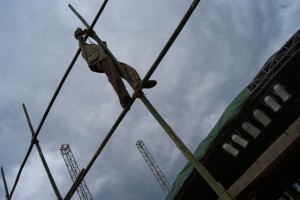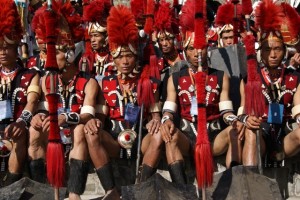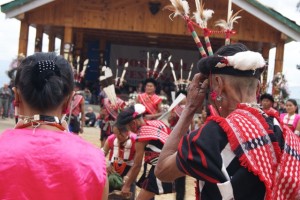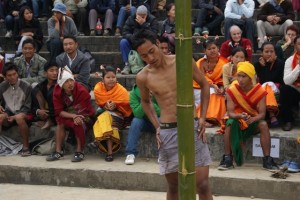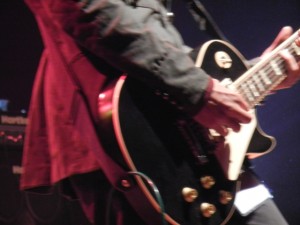(This is a reproduction of the travelogue I wrote for the North East Sun magazine published from New Delhi. Basically a compilation of the the individual accounts from each of the seven days, this is a quick reference for anyone who wants a glimpse of the festivities. Not so much details though. I have been getting requests to reproduce parts of the Hornbill account from Wanderink. Please go ahead, but kindly attribute the source to Wanderink.com, that’s all! Happy New Year!!)
The celebrations had started during my train journey from Guwahati to Dimapur. Suddenly out of nowhere, a bunch of silk-clad singing males and dancing damsels popped on to the platform. The train had stopped for tea. A local Assamese festival; I took it to be a warming up of sorts. This was my second time at the Hornbill Festival and I just couldn’t wait to reach Kohima where my friend from last year was waiting. The reason I love coming here is the people – every turn you meet someone who turns out to be nicer than the last one. And the stories – there is one in every step, around every corner. This year, I had come one day earlier as I wanted to see the sprucing up for the big day as well. A fire engine was spraying rain over the ceremony ground at Kisama, the festival venue, to settle the dust down. A giant black pig was being carted away pole-bound – for the thousands of momos which would be washed down over the next seven days with rice beer. Flower stands were being set up by dainty, sprightly women for the big day. Stalls were being freshly painted and nails hammered in for hanging up the red-feathered daos. There was the intoxicating smell of rice beer which wafted over the festival ground. I wasted no time in starting a morung-to-morung quality comparison: once the festival started, I would be busy. The Hornbill Festival – celebrated from December 1 to 7 – is a show of solidarity and peace among the 16 tribes of Nagaland. The festival is also related to the harvest cycles; over half the population of the state depends on agriculture for their livelihood. The opening day was a melee of martial dances, shrieking war cries, pounding on canoe-shaped drums and bursting energy. I walked around in an arena rendered surreal – a whole centuries-old culture was being played out, compacted and capsulated in the confines of a fair ground. The bull and the bolero became one. Colour charged the air. The pervading pride was palpable. Strings of tatiphe, the wordless houtho songs of the Angamis and the engrossing mooung songs by the elderly Changs…the first day of the Hornbill Festival featured enough teasers ensuring I hung around for more.The Nyalipu or Fish Dance of Konyaks, the Bai-Bin or the post-harvest folk dance of Dimasa, the Kuki’s Sagol Pheikai dance imitating the movements of the wild boar and the hornbill dance of Aos, the arena erupted to yells and yodels pregnant with narration. The enthralling display of sinewy stomping over, the tribes retreated to their respective morungs or huts to much-needed bamboo mugs of rice beer. The rhythmic rampage was to continue albeit on a smaller, more informal scale. Newly oiled hunting guns fired empty rounds in the air – their startle effect creating much merriment among tribe and tourist. Music and dance continued with gusto well into late afternoon. Pork was the staple that kept every limb moving. And the rice beer ensured there was no dearth of laughter and camaraderie. The Hornbill Rally is probably the only rally where your steering skills rub shoulders with your punk quotient. The car driven by two Sumi lads, besides the obvious ‘Warrior’ bold on the windscreen also had a spear, dao and a leather shield screwed painstakingly to the body. In addition to the warrior, there was the usual line-up: the elderly lady from Thailand whose abandon made you suspect she was on a bucket list. Her car sputtered twice before the start much to the embarrassment of her much younger navigator.
Taking off to such a roaring start, it was a superhuman task to hold on to the audience imagination and interest. So day three was a test on the organisers’ ingenuity and imagination. The carrots had done their job, the flitters had left and the real festival junkies slouched around to check whether the varnish peeled. With the honeymoon over and the real business of the festival settling in, the best way out was to rekindle the passion for storytelling so prevalent in the Naga culture.
The Pangan by the Chang tribe was a slomo dance with vigorous vocals to herald in the winter season. Tapping two conical hard leather instruments, the sound which would awaken the souls of the forefathers – to ensure victory in warfare, the Phoms took the arena with their ‘Blowing Horns’ ritual. The Bhandari Osho Sharu sounded very much like a church choir. Sung only on occasions by the Lothas, it celebrated the commemoration of the best warrior in the clan by the chief who would drape him with a shawl called the Longbensu. My personal favourite was the Akhu Keteli of the Rengmas. Here the young tribe members would visit the houses of newly married couples and dance outside singing, demanding the wife’s price from the groom – to be paid in meat or beer. The ritual purification dance of the Chakhesangs helped them keep their resolutions for the New Year; something like the Christian confession. Whether you wielded the dao or wore denim, I wondered at these striking pointers to a common genesis. Day three also saw the start of many inter-tribe competitions. The greased bamboo pole climbing didn’t see any winner despite an hour of wriggling up and slithering down. The organisers had to take down the poles and rub off most of the glistening fat with ragged jute. Whistles were blown again and the fastest to reach the top was adjudged winner. Well, rules are written to be rewritten. Over the next days there would be pork and chilly eating competitions.
The crowd let out a genuine cheer when the first lady’s name was announced for the pork eating competition. Each contestant was given one minute to finish four large chunks of pork – each of the whitest fat, boiled to blubbery softness with no condiments, not even salt. A gagging contestant was announced as ‘your Youtube moment’ by the MC – went on to show how social media had made a postcard of human suffering some probably even borne out of necessity. From a day with the beasts, I went on to a night with the beauties. Atsu Sekhose was evidently a local celebrity going by the fashion show was packed despite the ‘by invite only’ attendance. The third round, the evening wear, was stylish and sensuous. The female form was elegantly accentuated at times with touches of quirk. I found myself peering through the zoom in full bloom. For many, the Hornbill Festival is synonymous with its final gala – the rock festival. This is because any band worth its, well, rocks, have to earn its stripes from Hornbill. Preferably by winning. With screen days crowd of over 15,000 and close to seven times that on the finals, the benchmark is well set. There were over 100 applicants from all over the country from where 24 were screened and the final day saw the face-off between the nine ones shortlisted. On December 7 every year, the Indira Gandhi Stadium, 5 km from Kohima town, wakes up to acoustic checks throbbing with anticipation. Awaiting their turns, members of the nine final bands shared cigarettes, shared tips and appreciated each others’ talents and equipments. Watching the musicians encouraging and egging each other on was humbling: it was a world of constructive camaraderie and blotless bonhomie.
Like last year, this year too I came back enriched – with many more stories to share and new friendships to be cherished.



